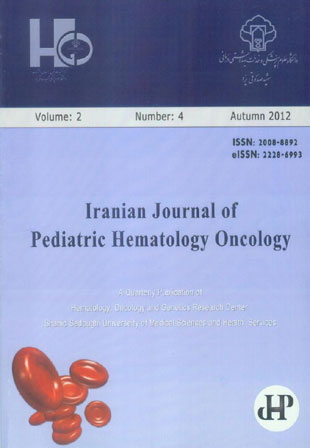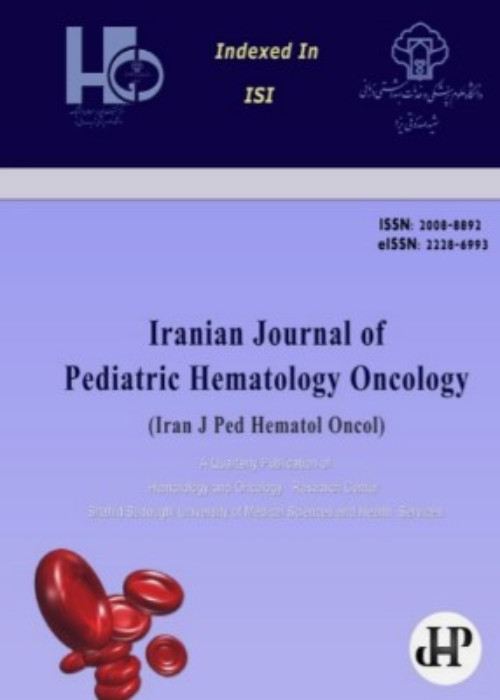فهرست مطالب

Iranian Journal of Pediatric Hematology and Oncology
Volume:2 Issue: 4, Autumn 2012
- تاریخ انتشار: 1391/10/11
- تعداد عناوین: 8
-
-
Page 133
Background There is a decrease in vaccine-specific antibody to certain vaccine-preventable diseases in children after chemotherapy, but the frequency of non-immune patients is not clear. In the present case-control study, was taken under investigation protection level to Hepatitis B infection in children 6 months after completing chemotherapy. Materials and Methods In this study 68 patients with cancer and 68 healthy children were enrolled. Patients were 1.5 -12 years old with completed standard chemotherapy at least for 6 months. All the patients and healthy children were negative for HBsAg and HBeAg and had received Hepatitis B vaccination. IgG antibody concentrations against Hepatitis B Virus (HBV) were determined in the patients receiving chemotrapy and healthy subjects serum by ELISA method. IgG antibody titer > 10 mIU/ml was considered as baseline protective titer for preventing HBV infection. Results Anti-HBs antibody titer in 19.12% of patients was less than 10 mIU/ml and 11.76% of the patients had borderline antibody titer (10-20 mIU/ml). In healthy subjects, 2.94% and 5.88% had antibody titer < 10 mIU/ml and 10-20 mIU/ml, respectively. According to statistical analysis, frequency of non immune subjects in children with cancer was significantly higher than those in healthy children (P-value=0.024). Conclusion HBV vaccination post-intensive chemotherapy in the children with cancer is strongly recommended.
Keywords: Hepatitis B, Vaccination, Immunity -
Page 140Background Hypertension is a major health problem, especially because it has no clear symptoms. It is strongly correlated with modifiable risk factors such as adiposities, age, stress, high salt intake. Overweight and obesity is conveniently determined from BMI and visceral adiposity is determined by waist circumference. ABO blood group is one such factor which needs to be investigated. The present study was performed to assess the association and distribution of hypertension, obesity, ABO blood groups in different categories of blood donors and its multipurpose future utilities for the health planners. Materials and Methods A retrospective study was carried out on 23, 320 blood donors during a period of one year. All the blood donors were measured BMI, ABO blood group, systolic and diastolic blood pressure were determined and correlated for each other. Results Hypertension of ABO blood group was B (8.7%) followed by group O (7.6%) group A (3.7%) and group AB (1.9%). In obesity of ABO blood group was B (7.9%) followed by group O (6.2%) group A (5.8%) and group AB (1.0%). Statistically significant difference was found in both groups (p < 0.001). Conclusion The B blood group in blood donor was more susceptible to hypertension and obesity.Keywords: Association, Hypertension, Obesity, Blood Donors
-
Page 146Introduction
Platelet aggregation plays a significant role in the etiology of cardiovascular diseases. Therefore، treatments to inhibit platelet aggregation can reduce the risk of coronary thrombosis. Several studies indicated that garlic can inhibit platelet aggregation. This study aimed to determine the effect of garlic in comparison with Plavix on platelet aggregation.
Materials and MethodsIn this randomized clinical trial، platelet aggregation and bleeding time was obtained from 36 healthy volunteers. Volunteers were randomly divided into 4 groups. The first، second and third groups respectively received 600، 1200 and 2400 mg garlic and the fourth group received 75 mg Plavix for three weeks. Afterwards، platelet aggregation and bleeding time were both evaluated and the results before and after the study were compared. Data were analyzed using SPSS software version 16.
ResultsPlatelet aggregation induced by adenosine diphosphate and arachidonic acid agonists decreased in the groups that used 1200 or 2400 mg garlic. This difference was statistically significant (p<0. 05). As compared to the other groups، the bleeding time also increased in those received 2400 mg garlic pill.
ConclusionSince garlic can inhibit platelet aggregation، it is suggested to use it as a supplementary treatment to reduce platelet aggregation is highly recommended.
Keywords: Bleeding Time, Garlic, Platelet Aggregation -
Page 153Background
β−Thalassemic children have oxidative stress and antioxidant deficiency even without iron overload status. In these patients، tissue damage due to oxidative stress may be occurred. Also، it seems that thalassemic patients have higher levels of ALT، AST therefore، the main aim of the present study was to determine the benefits of vitamin E as an antioxidant supplements in β-Thalassemia children.
Materials and MethodsThis clinical trial was carried out on 45 beta-thalassemic patients undergoing occasional transfusions (24 males، 21 females)، mean age 16± 8 years، admitted to Yazd and Shahid Sadoughi hospital in 2011. Fallowing three months treatment of vitaminE (vitamin E 400-600 unit/day)، liver function test and hemopoitic system parameters were measured.
ResultsFourty five patients with laboratory confirmation of β-Thalassemia were recruited following three months vitamin E supplementation، liver function test had higher improvement compared to hemopoitic system parameters، and also serum SGOT was significantly reduced (P-value<0. 004).
ConclusionIt seems clear that treatments of β-thalassemic patients with vitamins E have benefits in promoting antioxidant status and may improve liver function test، as AST and ALT to decrease but this supplement is not effective for hemopoietic system variables.
Keywords: Vitamin E Hemopoietic System_Liver Function Tests -
Page 159Background
Anemia is one of the most common abnormalities in pediatric medicine. Considerable differences are seen in the peripheral blood indices of infants in developing countries. The aim of this study was to determine and compared blood hemoglobin concentration in three sites of sampling in neonate.
Materials and Methods1600 term and preterm new infant in three sites of sampling (cord, capillary and venous) were taken under investigation. All neonates were examined during first day. The methodology excluded patients with a high likelihood of receiving blood transfusions and those who had a diagnosis of neonatal anemia. Finally, obtained data were analyzed and then compared to other hematology results.
ResultsMean hemoglobin value obtained from cord was 15.39+/- 5.39 SD and from capillary were 19.62+/- 5.75 SD and from venous were 17+/- 7.79 SD. Mean hemoglobin value of cord in term neonates were 15.4+/- 5.07 SD and pre term neonates were 14.77+/- 1.69 SD. (P=0.036) Mean hemoglobin value of capillary in term neonates were 19.63+/- 5.76 SD and pre term neonates were 18.85+/- 1.79 SD. (P=0.015) Mean hemoglobin value of venous in term neonates were 17.01+/- 7.81 SD and pre term neonates were 16.15+/- 1.76 SD. (P=0.012) There was a correlation between cord and capillary mean hemoglobin. (P=0.0235)
ConclusionsThe capillary samples had a higher mean hemoglobin concentration than other groups. There was no difference between these data with respect to the hemoglobin values for any groups.
Keywords: Anemia, Hemoglobins, Capillaries -
Page 164Background
Von Willebrand disease (VWD) is an autosomal recessive congenital bleeding disorder with deficiency or dysfunction of von Willebrand factor (VWF). The gene encoding for the VWF is located on chromosome 12, which is 178 Kb with 52 exons. Various mutations of this gene is responsible for the clinical features of VWD, but some single nucleotide polymorphisms make the molecular diagnosis of it very complicated.In this study genetic variations in two exons (45 & 16) of VWF gene in Iranian patients suffer from type 3 VWD from south west of Iran were evaluated.
Materials and MethodsGenetic variations in exon 45 and exon 16 of VWF gene were evaluated in 33 patients diagnosed with type 3 VWD from south west of Iran. Two exons with their flanking introns were amplified by PCR and amplicons were analyzed by sequencing for any molecular changes.
ResultsNo mutation was found in both selected regions. An A/C polymorphism in intron 44 was recognized in all patients in homozygous manner. This SNP reported for the first time from Iranian VWD patients.
ConclusionMutation of VWF gene is different in various ethnic groups, which finding of is important in the diagnosis of the VWD, especially for prenatal diagnosis. A few mutations are reported for exon 45 and 16 of this gene in Iran and other countries. But, present study didnt find any mutation in these patients. Mutation in other exons or introns should be evaluated in affected individuals from south west of Iran.
Keywords: Von Willebrand disease, Von Willebrand Factor, Single Nucleotide Polymorphism (SNP), Mutation, PCR, Sequencing -
Page 171Background
Frequent blood transfusion in patients with beta thalassemia major can lead to iron overload especially in liver. Chronic iron overload could cause cirrhosis of the liver. Transfusion- transmitted hepatitis B and C also could develop cirrhosis in individuals.
Materials and MethodsThe present cross- sectional descriptive study is to assess hepatomegaly and liver enzymes in 100 patients with beta thalassemia major, ages between 2-18 years old. The study was carried out retrospectively. One hundred medical records have chosen from 400 samples of thalassemia major patients, who are under a regular care of the department of sarvar clinic.
ResultsOut of these patients, 55% were male and 45% female. The mean age of thalassemia patients was 10.8 4.4 years. The mean and S. D of hemoglobin, ferritin, deferoxamine dosage was 8.5 ± 1.5g/dl, 2183 ± 1528 ng, 30 ± 11.16 mg/kg, respectively. Forty six percent of them had hepatomegaly. The mean and S. D of AST and ALT were 95± 70 IU/L and 70 ±35U/L respectively. Splenectomy was performed on 44% of patient.
ConclusionHepatomegaly is one of the most common findings in the thalassemic patient that induced with hemosiderosis and hepatitis.
Keywords: Epidemiology, Hepatomegaly, Liver, beta, Thalassemia -
Page 178Background
Immune deficiency in human might be primary or secondary and could be seen with a wide variety of manifestations. In the following, we presented a Child with various complains that diagnosed to have HIV infection.
Case ReportA 2/5 y/o child was admitted to the hospital for FUO with prolonged cough, FTT, cervical lymphadenopathy, hepatosplenomegaly and bilateral optic neuritis.. He was hospitalized for fever, cytopenia and hepatosplenomegaly one year ago, and three months later in an outpatient visit, these signs improved, except thrombocytopenia. In evaluation, bicytopenia, elevated ESR, hyperlipidemia, hyperproteinemia, thrombosis of the transverse sinus of brain, antiphospholipid antibodies, decreased levels of protein S and factor V Leiden and increased level of anti thrombin III were detected. Consequently, the result of HIV antibody showed positive. In addition to warfarin and cotrimoxazole therapy, he was referred to special center for possible HARRT therapy.
ConclusionIn approach to patients with various clinical presentations such as cytopenia, recurrent or persistent lymphadenopathy, unexplained hyperproteinemia or hyperlipidemia, evaluation of HIV infection is highly recommended for consideration and further therapy.
Keywords: HIV, Child, Signs, Symptoms


